Jing Bi
Diagnosing Visual Reasoning: Challenges, Insights, and a Path Forward
Oct 23, 2025Abstract:Multimodal large language models (MLLMs) that integrate visual and textual reasoning leverage chain-of-thought (CoT) prompting to tackle complex visual tasks, yet continue to exhibit visual hallucinations and an over-reliance on textual priors. We present a systematic diagnosis of state-of-the-art vision-language models using a three-stage evaluation framework, uncovering key failure modes. To address these, we propose an agent-based architecture that combines LLM reasoning with lightweight visual modules, enabling fine-grained analysis and iterative refinement of reasoning chains. Our results highlight future visual reasoning models should focus on integrating a broader set of specialized tools for analyzing visual content. Our system achieves significant gains (+10.3 on MMMU, +6.0 on MathVista over a 7B baseline), matching or surpassing much larger models. We will release our framework and evaluation suite to facilitate future research.
Video-LMM Post-Training: A Deep Dive into Video Reasoning with Large Multimodal Models
Oct 06, 2025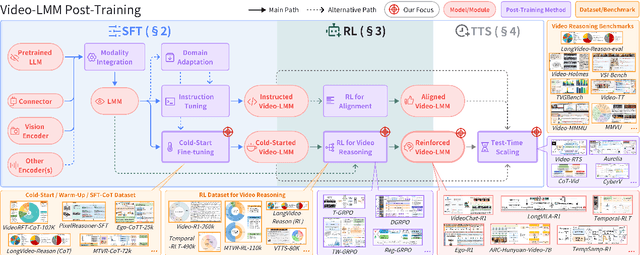
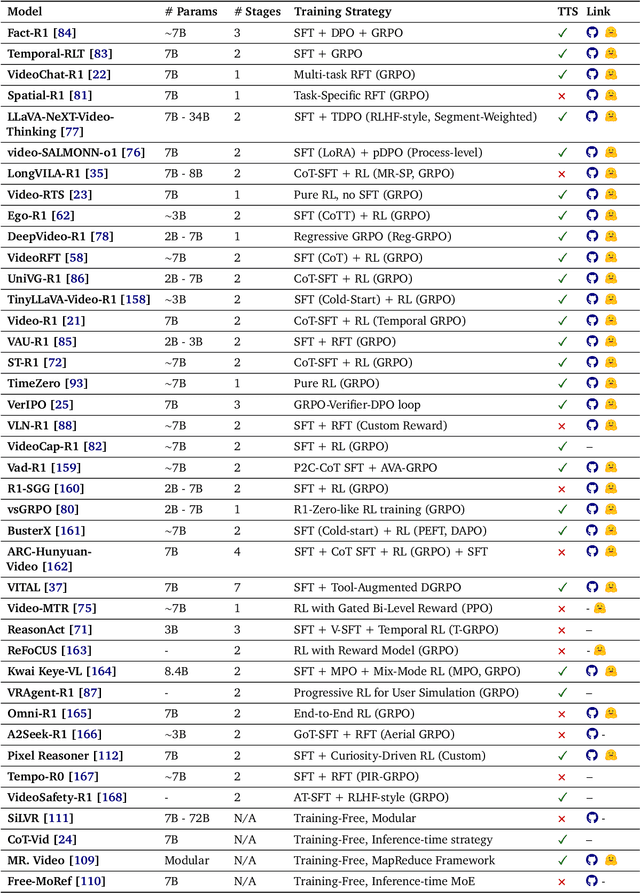
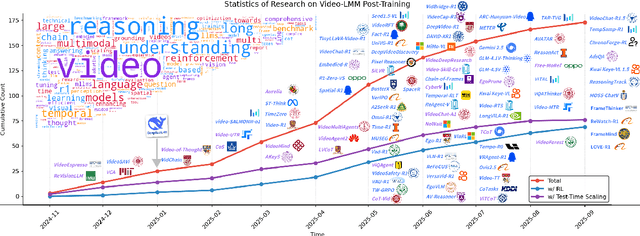
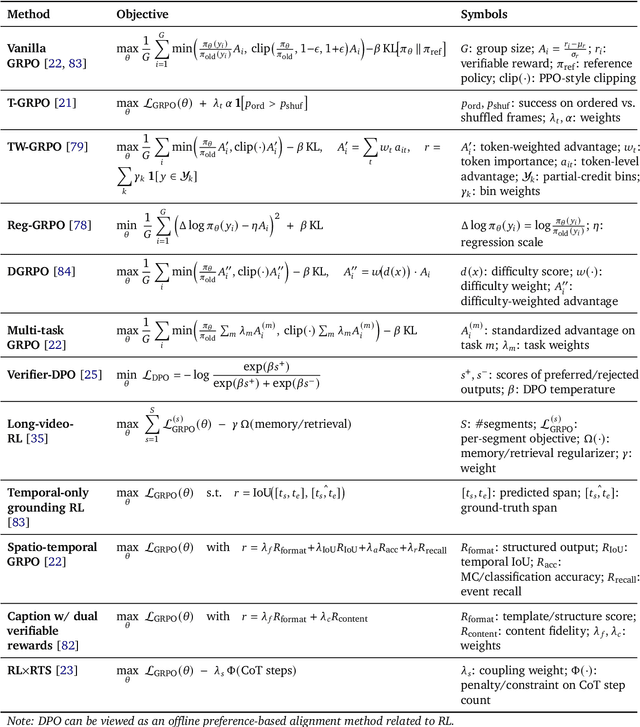
Abstract:Video understanding represents the most challenging frontier in computer vision, requiring models to reason about complex spatiotemporal relationships, long-term dependencies, and multimodal evidence. The recent emergence of Video-Large Multimodal Models (Video-LMMs), which integrate visual encoders with powerful decoder-based language models, has demonstrated remarkable capabilities in video understanding tasks. However, the critical phase that transforms these models from basic perception systems into sophisticated reasoning engines, post-training, remains fragmented across the literature. This survey provides the first comprehensive examination of post-training methodologies for Video-LMMs, encompassing three fundamental pillars: supervised fine-tuning (SFT) with chain-of-thought, reinforcement learning (RL) from verifiable objectives, and test-time scaling (TTS) through enhanced inference computation. We present a structured taxonomy that clarifies the roles, interconnections, and video-specific adaptations of these techniques, addressing unique challenges such as temporal localization, spatiotemporal grounding, long video efficiency, and multimodal evidence integration. Through systematic analysis of representative methods, we synthesize key design principles, insights, and evaluation protocols while identifying critical open challenges in reward design, scalability, and cost-performance optimization. We further curate essential benchmarks, datasets, and metrics to facilitate rigorous assessment of post-training effectiveness. This survey aims to provide researchers and practitioners with a unified framework for advancing Video-LMM capabilities. Additional resources and updates are maintained at: https://github.com/yunlong10/Awesome-Video-LMM-Post-Training
rQdia: Regularizing Q-Value Distributions With Image Augmentation
Jun 26, 2025Abstract:rQdia regularizes Q-value distributions with augmented images in pixel-based deep reinforcement learning. With a simple auxiliary loss, that equalizes these distributions via MSE, rQdia boosts DrQ and SAC on 9/12 and 10/12 tasks respectively in the MuJoCo Continuous Control Suite from pixels, and Data-Efficient Rainbow on 18/26 Atari Arcade environments. Gains are measured in both sample efficiency and longer-term training. Moreover, the addition of rQdia finally propels model-free continuous control from pixels over the state encoding baseline.
Can Sound Replace Vision in LLaVA With Token Substitution?
Jun 12, 2025Abstract:While multimodal systems have achieved impressive advances, they typically rely on text-aligned representations rather than directly integrating audio and visual inputs. This reliance can limit the use of acoustic information in tasks requiring nuanced audio understanding. In response, SoundCLIP explores direct audio-visual integration within multimodal large language models (MLLMs) by substituting CLIP's visual tokens with audio representations and selecting sound-relevant patch tokens in models such as LLaVA. We investigate two configurations: (1) projecting audio features into CLIP's visual manifold via a multilayer perceptron trained with InfoNCE on paired audio-video segments, and (2) preserving raw audio embeddings with minimal dimensional adjustments. Experiments with five state-of-the-art audio encoders reveal a fundamental trade-off. While audio-to-video retrieval performance increases dramatically (up to 44 percentage points in Top-1 accuracy) when audio is projected into CLIP's space, text generation quality declines. Encoders pre-trained with text supervision (CLAP, Whisper, ImageBind) maintain stronger generative capabilities than those focused primarily on audiovisual alignment (Wav2CLIP, AudioCLIP), highlighting the value of language exposure for generation tasks. We introduce WhisperCLIP, an architecture that fuses intermediate representations from Whisper, as well as AudioVisual Event Evaluation (AVE-2), a dataset of 580,147 three-second audiovisual clips with fine-grained alignment annotations. Our findings challenge the assumption that stronger cross-modal alignment necessarily benefits all multimodal tasks; instead, a Pareto frontier emerges wherein optimal performance depends on balancing retrieval accuracy with text generation quality. Codes and datasets: https://github.com/ali-vosoughi/SoundCLIP.
ZeroSep: Separate Anything in Audio with Zero Training
May 29, 2025Abstract:Audio source separation is fundamental for machines to understand complex acoustic environments and underpins numerous audio applications. Current supervised deep learning approaches, while powerful, are limited by the need for extensive, task-specific labeled data and struggle to generalize to the immense variability and open-set nature of real-world acoustic scenes. Inspired by the success of generative foundation models, we investigate whether pre-trained text-guided audio diffusion models can overcome these limitations. We make a surprising discovery: zero-shot source separation can be achieved purely through a pre-trained text-guided audio diffusion model under the right configuration. Our method, named ZeroSep, works by inverting the mixed audio into the diffusion model's latent space and then using text conditioning to guide the denoising process to recover individual sources. Without any task-specific training or fine-tuning, ZeroSep repurposes the generative diffusion model for a discriminative separation task and inherently supports open-set scenarios through its rich textual priors. ZeroSep is compatible with a variety of pre-trained text-guided audio diffusion backbones and delivers strong separation performance on multiple separation benchmarks, surpassing even supervised methods.
MMPerspective: Do MLLMs Understand Perspective? A Comprehensive Benchmark for Perspective Perception, Reasoning, and Robustness
May 26, 2025Abstract:Understanding perspective is fundamental to human visual perception, yet the extent to which multimodal large language models (MLLMs) internalize perspective geometry remains unclear. We introduce MMPerspective, the first benchmark specifically designed to systematically evaluate MLLMs' understanding of perspective through 10 carefully crafted tasks across three complementary dimensions: Perspective Perception, Reasoning, and Robustness. Our benchmark comprises 2,711 real-world and synthetic image instances with 5,083 question-answer pairs that probe key capabilities, such as vanishing point perception and counting, perspective type reasoning, line relationship understanding in 3D space, invariance to perspective-preserving transformations, etc. Through a comprehensive evaluation of 43 state-of-the-art MLLMs, we uncover significant limitations: while models demonstrate competence on surface-level perceptual tasks, they struggle with compositional reasoning and maintaining spatial consistency under perturbations. Our analysis further reveals intriguing patterns between model architecture, scale, and perspective capabilities, highlighting both robustness bottlenecks and the benefits of chain-of-thought prompting. MMPerspective establishes a valuable testbed for diagnosing and advancing spatial understanding in vision-language systems. Resources available at: https://yunlong10.github.io/MMPerspective/
$I^2G$: Generating Instructional Illustrations via Text-Conditioned Diffusion
May 22, 2025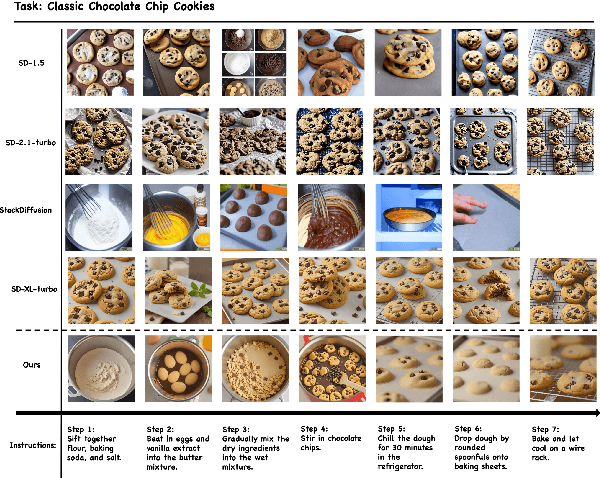
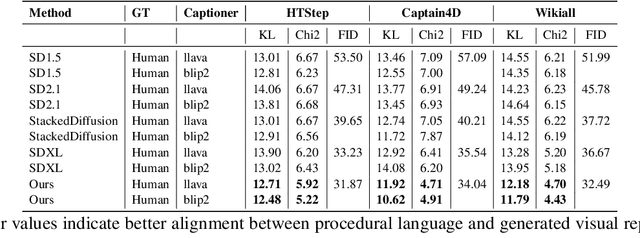
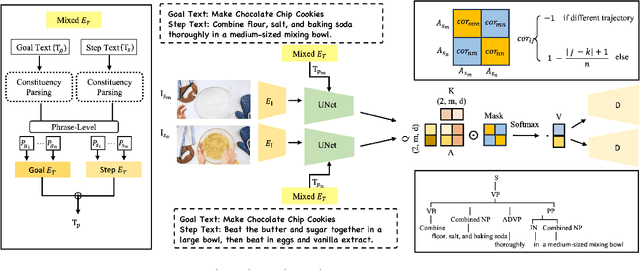

Abstract:The effective communication of procedural knowledge remains a significant challenge in natural language processing (NLP), as purely textual instructions often fail to convey complex physical actions and spatial relationships. We address this limitation by proposing a language-driven framework that translates procedural text into coherent visual instructions. Our approach models the linguistic structure of instructional content by decomposing it into goal statements and sequential steps, then conditioning visual generation on these linguistic elements. We introduce three key innovations: (1) a constituency parser-based text encoding mechanism that preserves semantic completeness even with lengthy instructions, (2) a pairwise discourse coherence model that maintains consistency across instruction sequences, and (3) a novel evaluation protocol specifically designed for procedural language-to-image alignment. Our experiments across three instructional datasets (HTStep, CaptainCook4D, and WikiAll) demonstrate that our method significantly outperforms existing baselines in generating visuals that accurately reflect the linguistic content and sequential nature of instructions. This work contributes to the growing body of research on grounding procedural language in visual content, with applications spanning education, task guidance, and multimodal language understanding.
Attention to Detail: Fine-Scale Feature Preservation-Oriented Geometric Pre-training for AI-Driven Surrogate Modeling
Apr 27, 2025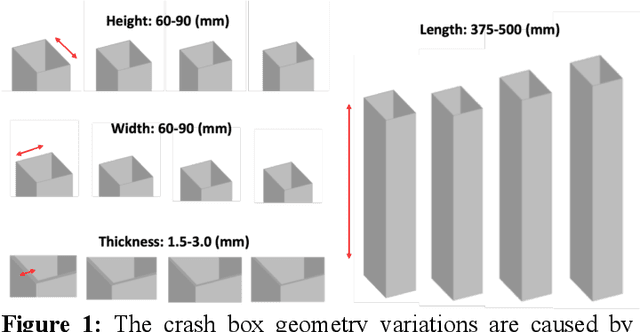

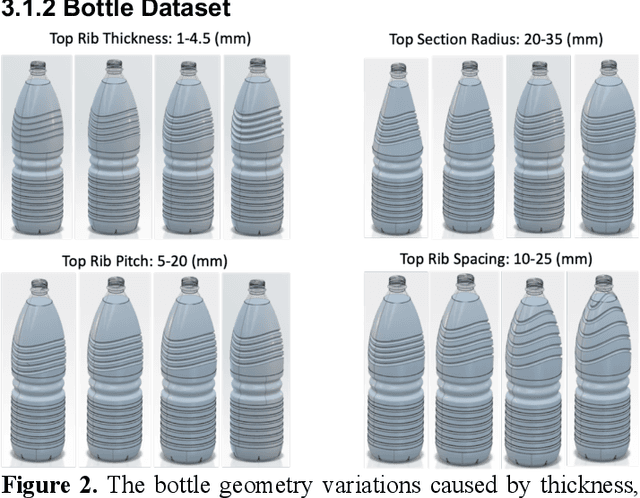

Abstract:AI-driven surrogate modeling has become an increasingly effective alternative to physics-based simulations for 3D design, analysis, and manufacturing. These models leverage data-driven methods to predict physical quantities traditionally requiring computationally expensive simulations. However, the scarcity of labeled CAD-to-simulation datasets has driven recent advancements in self-supervised and foundation models, where geometric representation learning is performed offline and later fine-tuned for specific downstream tasks. While these approaches have shown promise, their effectiveness is limited in applications requiring fine-scale geometric detail preservation. This work introduces a self-supervised geometric representation learning method designed to capture fine-scale geometric features from non-parametric 3D models. Unlike traditional end-to-end surrogate models, this approach decouples geometric feature extraction from downstream physics tasks, learning a latent space embedding guided by geometric reconstruction losses. Key elements include the essential use of near-zero level sampling and the innovative batch-adaptive attention-weighted loss function, which enhance the encoding of intricate design features. The proposed method is validated through case studies in structural mechanics, demonstrating strong performance in capturing design features and enabling accurate few-shot physics predictions. Comparisons with traditional parametric surrogate modeling highlight its potential to bridge the gap between geometric and physics-based representations, providing an effective solution for surrogate modeling in data-scarce scenarios.
Caption Anything in Video: Fine-grained Object-centric Captioning via Spatiotemporal Multimodal Prompting
Apr 09, 2025Abstract:We present CAT-V (Caption AnyThing in Video), a training-free framework for fine-grained object-centric video captioning that enables detailed descriptions of user-selected objects through time. CAT-V integrates three key components: a Segmenter based on SAMURAI for precise object segmentation across frames, a Temporal Analyzer powered by TRACE-Uni for accurate event boundary detection and temporal analysis, and a Captioner using InternVL-2.5 for generating detailed object-centric descriptions. Through spatiotemporal visual prompts and chain-of-thought reasoning, our framework generates detailed, temporally-aware descriptions of objects' attributes, actions, statuses, interactions, and environmental contexts without requiring additional training data. CAT-V supports flexible user interactions through various visual prompts (points, bounding boxes, and irregular regions) and maintains temporal sensitivity by tracking object states and interactions across different time segments. Our approach addresses limitations of existing video captioning methods, which either produce overly abstract descriptions or lack object-level precision, enabling fine-grained, object-specific descriptions while maintaining temporal coherence and spatial accuracy. The GitHub repository for this project is available at https://github.com/yunlong10/CAT-V
Why Reasoning Matters? A Survey of Advancements in Multimodal Reasoning (v1)
Apr 04, 2025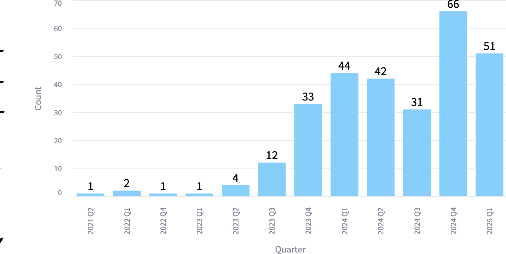
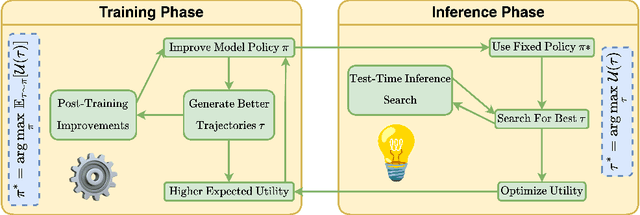
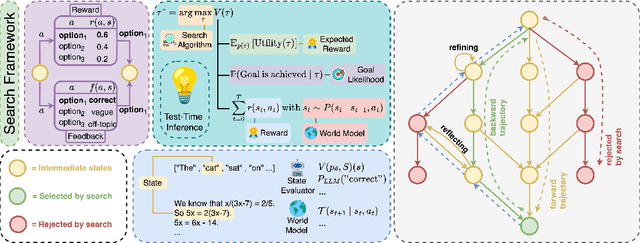
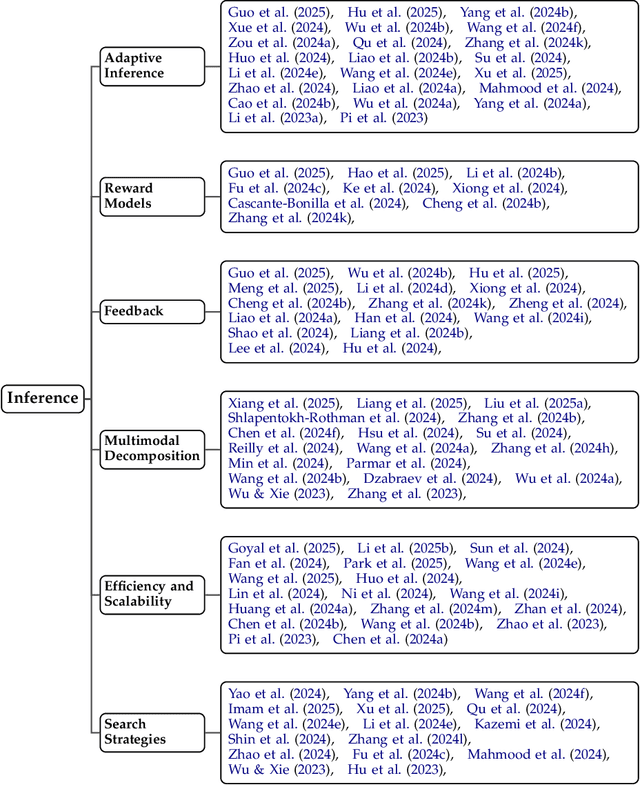
Abstract:Reasoning is central to human intelligence, enabling structured problem-solving across diverse tasks. Recent advances in large language models (LLMs) have greatly enhanced their reasoning abilities in arithmetic, commonsense, and symbolic domains. However, effectively extending these capabilities into multimodal contexts-where models must integrate both visual and textual inputs-continues to be a significant challenge. Multimodal reasoning introduces complexities, such as handling conflicting information across modalities, which require models to adopt advanced interpretative strategies. Addressing these challenges involves not only sophisticated algorithms but also robust methodologies for evaluating reasoning accuracy and coherence. This paper offers a concise yet insightful overview of reasoning techniques in both textual and multimodal LLMs. Through a thorough and up-to-date comparison, we clearly formulate core reasoning challenges and opportunities, highlighting practical methods for post-training optimization and test-time inference. Our work provides valuable insights and guidance, bridging theoretical frameworks and practical implementations, and sets clear directions for future research.
 Add to Chrome
Add to Chrome Add to Firefox
Add to Firefox Add to Edge
Add to Edge